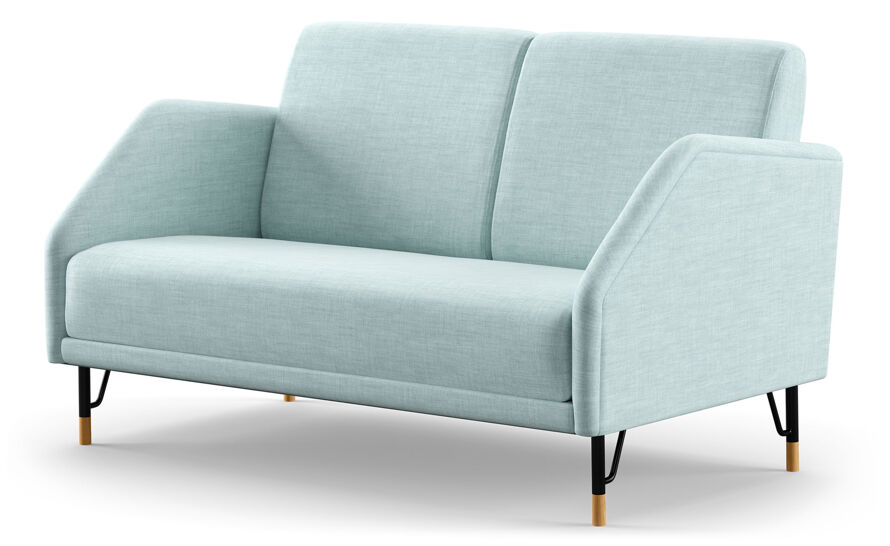Model 77 Sofa 2 Seater
by Finn Juhl from house of finn juhl
model 77 sofa 2 seater
Design Finn Juhl, 1953
Solid oak or walnut toes, steel legs, fabric upholstery
Made in Denmark by House of Finn Juhl
Inspired by his American colleagues, Finn Juhl designed a new series of furniture in 1953 with a streamlined and more industrial aesthetic. Among these was the 77 Sofa, whose upholstered body appears to be floating on the delicate, almost invisible frame made from burnished steel. The sofa is manufactured in Denmark on a solid blind frame in beech, upholstered and hand-stitched according to traditional craftsmanship. Both the fixed seat and the loose back cushion are with spring inserts, ensuring both comfort and durability. The 77 Sofa is available in textile, with burnished steel legs and wooden toes in oak or walnut.
As the only Danish designer on the international scene in the beginning of the 1950s, Finn Juhl had made his mark in the US and brought ideas back home. Inspired by his American colleagues, he managed to incorporate an international touch into furniture that was carried on slender legs in burnished or painted steel with wooden toes. One of these new furniture models was the 77 Series that evokes memories of the international airport lounges and hotel lobbies of the 50s and 60s, as well as architect-designed homes with large windows and graphic freestanding interiors.
During the 1950s, Finn Juhl embarked on a departure from solely designing furniture for exclusive, handmade production in limited quantities. Instead, he set out to explore the possibilities within industrial production. It was at Bevirke in Frederiksberg where Finn Juhl found the first Danish furniture manufacturer who shared his vision of blending the finesse and aesthetic of traditional craftsmanship with the vast potential offered by the industry. Creating entirely new furniture types posed a challenge, yet despite the obstacles, the partnership between Finn Juhl and Bovirke yielded a range of successful furniture pieces that set new standard for industrially produced design furniture in Denmark. Among these new creations, the 77 Series symbolized this new direction. Finn Juhl himself used the 77 Sofa in his showroom apartment in the Bellahøj high-rise building complex as well as in many of the 33 SAS terminals he designed between 1957 and 1961.
Behind the rather modest and simple exterior of the 77 Sofa lies time-consuming craftsmanship and materials of the finest quality. House of Finn Juhl produces the re-launched version in Denmark, as originally, on a solid blind frame in beech, upholstered and hand-stitched according to traditional craftsmanship in textile.
52.4" w | 31.1" d | 31.1" h | seat: 16" h
Solid oak or walnut toes, steel legs, fabric upholstery
Made in Denmark by House of Finn Juhl
Inspired by his American colleagues, Finn Juhl designed a new series of furniture in 1953 with a streamlined and more industrial aesthetic. Among these was the 77 Sofa, whose upholstered body appears to be floating on the delicate, almost invisible frame made from burnished steel. The sofa is manufactured in Denmark on a solid blind frame in beech, upholstered and hand-stitched according to traditional craftsmanship. Both the fixed seat and the loose back cushion are with spring inserts, ensuring both comfort and durability. The 77 Sofa is available in textile, with burnished steel legs and wooden toes in oak or walnut.
As the only Danish designer on the international scene in the beginning of the 1950s, Finn Juhl had made his mark in the US and brought ideas back home. Inspired by his American colleagues, he managed to incorporate an international touch into furniture that was carried on slender legs in burnished or painted steel with wooden toes. One of these new furniture models was the 77 Series that evokes memories of the international airport lounges and hotel lobbies of the 50s and 60s, as well as architect-designed homes with large windows and graphic freestanding interiors.
During the 1950s, Finn Juhl embarked on a departure from solely designing furniture for exclusive, handmade production in limited quantities. Instead, he set out to explore the possibilities within industrial production. It was at Bevirke in Frederiksberg where Finn Juhl found the first Danish furniture manufacturer who shared his vision of blending the finesse and aesthetic of traditional craftsmanship with the vast potential offered by the industry. Creating entirely new furniture types posed a challenge, yet despite the obstacles, the partnership between Finn Juhl and Bovirke yielded a range of successful furniture pieces that set new standard for industrially produced design furniture in Denmark. Among these new creations, the 77 Series symbolized this new direction. Finn Juhl himself used the 77 Sofa in his showroom apartment in the Bellahøj high-rise building complex as well as in many of the 33 SAS terminals he designed between 1957 and 1961.
Behind the rather modest and simple exterior of the 77 Sofa lies time-consuming craftsmanship and materials of the finest quality. House of Finn Juhl produces the re-launched version in Denmark, as originally, on a solid blind frame in beech, upholstered and hand-stitched according to traditional craftsmanship in textile.
52.4" w | 31.1" d | 31.1" h | seat: 16" h
Finn Juhl
Finn Juhl aimed at a more organic and natural design form without role models or inherited restrictions. He designed by measuring his own body and analyzing how the individual components of the chair should carry the human body.
Finn Juhl’s design universe is a joyful journey of shapes, aesthetics and inspiration. These classic Danish Modern masterpieces are authorized, licensed & manufactured in Denmark with respect for heritage and quality.












 write a review now
write a review now
